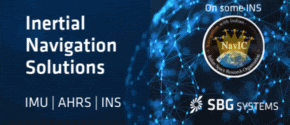| GNSS | |
GNSS
Thales invests €55M to boost next gen resilient navigation in France
Thales has announced a major €55 million investment to strengthen its industrial sites in Châtellerault and Valence, France. This investment, which will be made between 2025 and 2028, will meet the growing demand for high-performance navigation solutions, both civilian and military.
In a context of increasing jamming and spoofing of GNSS signals, Thales is deploying a complete range of resilient navigation solutions that combine precision, autonomy, and security. These technologies are essential to ensure operational continuity, whether for critical military missions or civil aviation safety.
By integrating two technological pillars combining inertial systems and GNSS signal reception, Thales enables reliable navigation even in contested environments. Autonomous navigation capability is maintained at all times due to the high performance of the TopAxyz inertial navigation systems. Signal reception integrity is ensured by combining the encrypted, multi constellation TopStar-M receiver with the TopShield anti-jamming solution. These innovations are supported by France’s Directorate General of Armaments (DGA) under the OMEGA (Operation for the Modernization of GNSS Equipment of the Armed Forces) programme. The performance and unique combination of these solutions make Thales the European leader in resilient navigation.
At Châtellerault, the production capacity of inertial navigation systems will be increased fourfold, with a gradual ramp up through 2028. In Valence, mass production of TopStar-M receivers and TopShield systems will begin in 2026.
Satellite-based toll collection may take few more years: NHAI
Officials from the National Highways Authority of India (NHAI) have said that the Global Navigation Satellite System (GNSS)-based electronic toll collection system will not be implemented anytime soon.
The officials, who were part of a pilot study in this regard, said that absence of On-Board Units (OBU) in many vehicles and privacy concerns regarding their exact location being shared are some of the reasons for this decision. It may take a few years for the launch of the satellite-based toll collection system.
An NHAI official said they selected Bengaluru-Mysuru access-controlled highway and Panipat-Hisar highway in Haryana last year for the pilot study along with the FASTag facility. Based on the distance travelled, the toll will be deducted/ collected. A stretch of Bengaluru-Mysuru highway was selected and geo-fenced for the study. A report was submitted to NHAI officials after conducting the study last year,” the official said. He said the project could not be implemented anytime soon because only a few vehicles have OBUs.
13 member states call for EU response to GNSS interference
13 EU member states, including Latvia, have called on the European Commission to respond to interference with Global Navigation Satellite Systems (GNSS) in EU countries.
The ministers for transport and digital affairs from 13 countries have sent a joint letter to the European Commission, urging immediate and coordinated action in response to interference with GNSS originating from Russia and Belarus. Following Lithuania’s initiative, the letter also highlights the urgent need to accelerate the deployment of interference-resistant GNSS services, enhance the overall resilience of critical infrastructure, and strengthen safety and security across Europe.
In the letter addressed to the High Representative for Foreign Affairs and Security Policy and Vice-President of the European Commission, Kaja Kallas; Commissioner for Defense and Space, Andrius Kubilius; Commissioner for IATA and EASA release joint strategy to counter GNSS interference risks Sustainable Transport and Tourism, Apostolos Tzitzikostas and other members of the European Commission, the ministers emphasize that since 2022, two types of interference to GNSS – jamming and spoofing – have been observed in the airspace of the Baltic Sea Region, posing a threat to various modes of transport, particularly civil aviation and maritime navigation.
The joint letter signed by the ministers of Lithuania, Latvia, Estonia, Germany, Slovakia, Finland, Slovenia, the Czech Republic, Italy, the Netherlands, Spain, Denmark, and Romania, also states that that GNSS interference cases are not random incidents but a systematic, deliberate action by Russia and Belarus, which can be used as a hybrid attack on strategic radio spectrum, essential for modern technology, regional safety, and security, particularly in transport.
Furthermore, the ministers call on the EU to increase diplomatic efforts to address the interference and apply pressure on the responsible parties, including legal action against responsible individuals and entities involved in the deliberate interference with GNSS signals, to enhance European safety and security.
Among other immediate actions, the ministers propose to intensify radio frequency monitoring and enhance civil-military coordination mechanisms among Member States for shared monitoring, data exchange, and possible response to GNSS interference. They also advocate for accelerating the deployment of interference-resistant GNSS services, particularly the anti spoofing features of the Galileo program, and for upgrading and modernizing conventional navigation infrastructure.
In late February, Lithuanian presidential national security advisor Marius Cesnulevicius said that GPS interference had to do with Russia’s step taken to defend itself from Ukraine’s retaliatory strikes on Russian territory, adding that Lithuania was not a specific target. www.baltictimes.com
IATA and EASA release joint strategy to counter GNSS interference risks
The International Air Transport Association (IATA) and the European Union Aviation Safety Agency (EASA) have published a comprehensive plan to mitigate risks stemming from GNSS interference. The plan was part of the conclusions from a jointly hosted workshop on the topic of GNSS interference.
With incidents of GNSS signal jamming and spoofing rising, especially in Eastern Europe and the Middle East, the workshop called for a broader, more coordinated response. The plan focuses on four areas: improving information gathering, strengthening prevention and mitigation, making better use of infrastructure and airspace management, and enhancing coordination among agencies.
According to IATA, the number of GPS signal loss events increased by 220% between 2021 and 2024. “With continued geopolitical tensions, it is difficult to see this trend reversing in the near term,” said Nick Careen, IATA senior vice president for operations, safety, and security. “The next step is for ICAO to move these solutions forward with global alignment on standards, guidance, and reporting. This must command a high priority at the ICAO Assembly later this year.”
Detailed Workshop Outcomes
The workshop concluded that four workstreams are critical:
1. Enhanced Reporting and Monitoring
▪ Agree on standard radio calls for reporting GNSS interference and standardized notice to airmen (NOTAM) coding, i.e. Q codes.
▪ Define and implement monitoring and warning procedures, including real-time airspace monitoring.
▪ Ensure dissemination of information without delays to relevant parties for formal reporting.
2. Prevention and Mitigation
▪ Tighten controls (including export and licensing restrictions) on jamming devices. x NEWS – IMAGING
▪ Support the development of technical solutions to:
▫ reduce false terrain warnings;
▫ improve situational interference with portable spoofing detectors; and
▫ ensure rapid and reliable GPS equipment recovery after signal loss or interference.
3. Infrastructure and Airspace Management
▪ Maintain a backup for GNSS with aminimum operational network of traditional navigation aids.
▪ Better utilize military air traffic management (ATM) capabilities,including tactical air navigation networks and real-time airspace GNSS incident monitoring.
▪ Enhance procedures for airspace contingency and reversion planning so that aircraft can navigate safely even in the event of interference.
4. Coordination and Preparedness
▪ Improve civil-military coordination, including the sharing of GNSS radio frequency interference (RFI) event data.
▪ Prepare for evolving threat capabilities, including those related to drones.
The workshop was held May 22-23 at EASA headquarters in Cologne, Germany. www.iata.org
DHS S&T releases tool to strengthen GNSS for critical infrastructure
The Department of Homeland Security (DHS) Science and Technology Directorate (S&T) launched an important new resource on GitHub to help safeguard critical infrastructure: the Global Navigation Satellite System (GNSS) Test Vector Suite and Distribution Methodology. This effort supports Executive Order 13905, which aims to protect essential Positioning, Navigation and Timing (PNT) systems used in industries like energy, transportation and telecommunications.
PNT systems rely on accurate GNSS signals to function properly. If these GeoTerra selects Vexcel’s UltraCam Merlin 4.1 GeoTerra, USA has acquired the UltraCam Merlin 4.1 2010 digital aerial camera system by Vexcel Imaging. This marks GeoTerra’s transition to Vexcel’s fourth-generation camera systems signals are disrupted – whether by natural events, technical failures, or cyber threats – critical services could be impacted. To address this risk, the GNSS Test Vector Suite and Distribution Methodology provides critical infrastructure owners and operators the tools to independently identify and define appropriate test scenarios that support standards conformity assessments, to help evaluate and improve the resilience of their systems.
The GNSS Test Vector Suite includes a standardized set of test scenarios and tools that allow developers and testers to assess how well their equipment can handle challenges like signal interference or spoofing attempts. The process works as follows:
1. The GNSS Test Vector Suite generates simulated data
2. The data is converted into signals that mimic real-world GNSS systems
3. These signals are fed into designated GNSS devices or other PNT equipment, enabling users to evaluate how their systems respond to simulated disruptions
By offering this testing capability, S&T is helping critical infrastructure operators identify vulnerabilities in PNT systems and ensure they meet established resilience standards. This is a critical step in protecting the essential systems that Americans rely on every day. www.dhs.gov
Topcon and Vemcon sign MoU
Topcon Positioning Systems has has signed a Memorandum of Understanding (MOU) with Vemcon GmbH to initiate a collaboration to expand the availability of advanced excavator technology solutions across the EMEA regions and additional global markets. The collaboration would bring together complementary strengths from both organizations: Vemcon’s expertise in 2D assistance systems and Topcon’s advanced 3D machine control technology and global GNSS network. topcon.com












 (No Ratings Yet)
(No Ratings Yet)





Leave your response!